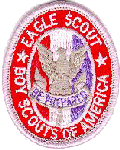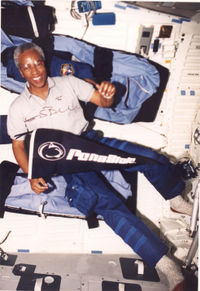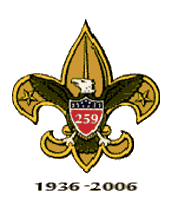Guion Bluford 

Guion "Guy" Bluford, Junior (born November 22, 1942) is a retired Colonel, from the United States Air Force and a former NASA Astronaut. He participated in four flights of Space Shuttle between 1983 and 1992. In 1983, as a member of the crew of the space shuttle Challenger on mission STS-8, Bluford became the first African American in space. (Note that the first black man in space was the Cuban cosmonaut Arnaldo Tamayo Méndez.)
Early life and career
Bluford was born in Philadelphia, Pennsylvania. He received a BS in aerospace engineering from the Pennsylvania State University in 1964; a MS in aerospace engineering from the Air Force Institute of Technology in 1974; a PhD in aerospace engineering with a minor in laser physics from the Air Force Institute of Technology in 1978, and a Master of Business Administration from the University of Houston-Clear Lake in 1987.
Prior to becoming an astronaut, he attended pilot training at Williams Air Force Base, Arizona, and received his pilot wings in January 1966. He then went to F-4C combat crew training in Arizona and Florida and was assigned to the 557th Tactical Fighter Squadron, Cam Ranh Bay, Vietnam. He flew 144 combat missions, 65 of which were over North Vietnam.
In July 1967, he was assigned to the 3,630th Flying Training Wing, Sheppard Air Force Base, Texas, as a T-38A instructor pilot. He served as a standardization/evaluation officer and as an assistant flight commander. In early 1971, he attended Squadron Officers School and returned as an executive support officer to the Deputy Commander of Operations and as School Secretary for the Wing.
In August 1972, he entered the Air Force Institute of Technology residency school at Wright-Patterson Air Force Base, Ohio. Upon graduating in 1974, he was assigned to the Air Force Flight Dynamics Laboratory at Wright-Patterson Air Force Base, Ohio, as a staff development engineer. He served as deputy for advanced concepts for the Aeromechanics Division and as branch chief of the Aerodynamics and Airframe Branch in the Laboratory. Bluford has written and presented several scientific papers in the area of computational fluid dynamics.
NASA experience
Bluford became a NASA astronaut in August 1979. His technical assignments have included working with Space Station operations, the Remote Manipulator System (RMS), Spacelab systems and experiments, Space Shuttle systems, payload safety issues and verifying flight software in the Shuttle Avionics Integration Laboratory (SAIL) and in the Flight Systems Laboratory (FSL). Bluford was a mission specialist on STS-8, STS-61-A, STS-39, and STS-53.
Bluford's first mission was STS-8, which launched from Kennedy Space Center, Florida, on August 30, 1983. This was the third flight for the Orbiter Challenger and the first mission with a night launch and night landing. During the mission, the STS-8 crew deployed the Indian National Satellite (INSAT-1B); operated the Canadian-built RMS with the Payload Flight Test Article (PFTA); operated the Continuous Flow Electrophoresis System (CFES) with live cell samples; conducted medical measurements to understand biophysiological effects of space flight; and activated four "Getaway Special" canisters. STS-8 completed 98 orbits of the Earth in 145 hours before landing at Edwards Air Force Base, California, on September 5, 1983.
Bluford then served on the crew of STS-61-A, the German D-1 Spacelab mission, which launched from Kennedy Space Center, Florida, on October 30, 1985. This mission was the first to carry eight crew members, the largest crew to fly in space and included three European payload specialists. This was the first dedicated Spacelab mission under the direction of the German Aerospace Research Establishment (DFVLR) and the first U.S. mission in which payload control was transferred to a foreign country (German Space Operations Center, Oberpfaffenhofen, Germany). During the mission, the Global Low Orbiting Message Relay Satellite (GLOMR) was deployed from a "Getaway Special" (GAS) container, and 76 experiments were performed in Spacelab in such fields as fluid physics, materials processing, life sciences, and navigation. After completing 111 orbits of the Earth in 169 hours, Challenger landed at Edwards Air Force Base, California, on November 6, 1985.
Bluford also served on the crew of STS-39, which launched from the Kennedy Space Center, Florida, on April 28, 1991, aboard the Orbiter Discovery. The crew gathered aurora, Earth-limb, celestial, and Shuttle environment data with the AFP-675 payload. This payload consisted of the Cryogenic Infrared Radiance Instrumentation for Shuttle (CIRRIS-1A) experiment, Far Ultraviolet Camera experiment (FAR UV), the Uniformly Redundant Array (URA), the Quadrupole Ion Neutral Mass Spectrometer (QINMS), and the Horizon Ultraviolet Program (HUP) experiment. The crew also deployed and retrieved the SPAS-II which carried the Infrared Background Signature Survey (IBSS) experiment. The crew also operated the Space Test Payload-1 (STP-1) and deployed a classified payload from the Multi-Purpose Experiment Canister (MPEC). After completing 134 orbits of the Earth and 199 hours in space, Discovery landed at the Kennedy Space Center, Florida, on May 6, 1991.
More recently, Bluford served on the crew of STS-53 which launched from the Kennedy Space Center, Florida, on December 2, 1992. The crew of five deployed the classified Department of Defense payload DOD-1 and then performed several Military-Man-in-Space and NASA experiments. After completing 115 orbits of the Earth in 175 hours, Discovery landed at Edwards Air Force Base, California, on December 9, 1992.
With the completion of his fourth flight, Bluford has logged over 688 hours in space.
Bluford left NASA in July 1993 to take the post of Vice President/General Manager, Engineering Services Division of NYMA, Greenbelt, Maryland.
Challenger Flag
Guy Bluford, who is an Eagle Scout, was designated as the emissary to return the Challenger flag to Boy Scout Troop 514 of Monument, Colorado in December, 1986. On December 18 of that year, he presented the flag to the troop in a special ceremony at Falcon Air Force Base.

